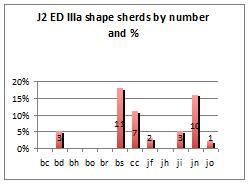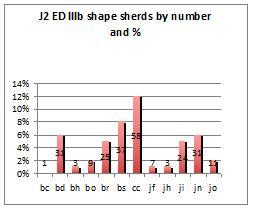Back to top: Ceramics from Unit J2
Methodology
The ceramics from this unit, excavated in 2 seasons (2001 and 2002) have all been analyzed in the field. This means that the ceramics from all contexts are included in this database. All body sherds were analyzed based on our site-wide descriptions of the wares found on the site. If these sherds are decorated then they are described according to codes established for decoration technique and design elements. The shapes are categorized through comparison with a basic shape catalog containing 150 types (and a number of variations) covering all the major shapes made during the time periods the site was in use. When only the rim is found and the vessel shape cannot be determined from it, then these rims are categorized through a catalog of rim typeThe criteria and procedures for choosing the features to analyze from this unit were the same as for all units of the excavation. These are different for the time during the actual excavation of the unit and for the study season which immediately followed the excavation season or for work on them during subsequent seasons. During the individual excavation seasons, topsoil features were described only and sherds taken to be drawn and further analyzed only if they were typologically interesting and considered important to add to the basic form and decoration catalog for that period. Twenty-two topsoil features in J2, which included 145 sherd lots, were described and are found here in the feature descriptions.
Sherds from features considered significant by the excavators, in consultation with me, were completely analyzed if time permitted during the season in which they were excavated. In every case, however, all important features based on the stratigraphic context as determined by the excavators, were checked by me in order to provide the excavators the date of the feature. Toward the end of the 2010 season we began a concerted effort to analyze the ceramics from all the remaining J2 features and it was in this period that a number of Mittani features were analyzed. At the end of the 2010 season, in addition to the topsoil feature descriptions of ceramics, 434q-lots had been fully analyzed making up 49% of the corpus. Unfortunately we did not complete the analysis of the remaining 305 sherd lots during 2010 and had the intention of starting the 2011 season by completing the analysis of this corpus. Subsequent events did not allow us to return to the field in 2011.
When all sherds are not analyzed the criteria for choosing the features for analysis is approximately the same for all units except when a decision is made to analyze all the sherds from a particular unit. The choice in the case of a partial analysis during the time frame available is based first on chronological questions. At the same time the determination of function is significant based on characteristics found in the stratigraphy, architecture, objects or ceramics.
Body sherd analysis is faster than shape analysis and therefore some features have only body sherds analyzed. This does not necessarily indicate that there were no shape sherds in the q-lot, only that there may not be any shape sherds. The converse does not hold for the features with shape sherds analyzed only, if there are no body sherds analyzed for the feature, that means that there were no body sherds found in that feature. This is usually the case when the features included few sherds.s; the same is true for bases. While we have very few handles in the time periods represented at the site, we do have a catalog of handle types also.
Back to top: Ceramics from Unit J2
Overall Character of the Sherd Data in J2
The overall character of the sherd data we collected from J2 can be seen in the statistics shown here in the J2 tabulations sections. If we consider first the wares, Chaff ware (CH) represented a very large percentage of the sherds (67%). This very high percentage is also found in J1 on the exterior of the revetment wall with 70% CH ware found there. In A16 above the palace CH represented 58% of the total number of sherds recovered from a data set of over 61,000 sherds. Fine Chaff in the J2 data equals 15% while in J1the percentage is lower at 12% and in A16, 13%. Pebble tempered ware (P), used almost exclusively for cooking pots, totaled 5% in J2 and 4% in J1.
If we look at the overall shape categories of jars, bowls and cups then in J2 jars are 47% and interestingly in J1 jars represent only 33% of the total, a 13% points of difference. The bowls numbers are closer together at 37% in J2 and 45% in J1, an 8 percentage point difference. Cups have a higher percentage in J2 with 9% but the difference is not great in comparison with J1 where cups represent 5%. If we look at the percentages then in J2 and J1, there is approximately the same percentage of jars in J2 as that of bowls in J1. Alternately in J2 the bowls represent about the same percentage as the jars in J1. The approximate differences are made up by the greater percentage of cups in J2 (9%) than J1 (5%). Also interestingly these three overall categories of vessels represent 92% of the vessel shapes from J2 and only 83% in J1.
While these all-inclusive totals represent a significant time span and a wide range of different use areas, they are a powerful indication of the continuity of potting practices within the city. Pictured here then is a significant continuity within a craft tradition which is fundamental to the life of any city. It indicates a stability in the production of basic goods and by extension of a certain economic stability. And combined with other cultural indicators they help to build up an argument for the identification of an overall function of these spaces. This topic is discussed further in both the JP book and the Mozan Sitewide book.
Back to top: Ceramics from Unit J2
Chronological Implications: Third Millennium Ceramics
As in other areas along the revetment wall west of the stairway and in the plaza in areas we have excavated along the revetment wall there are no transitional strata between late ED III and early Mittani. The few sherds noted from Phases 3 and 4 in J2f197 and J2f200 must be intrusive from the strata dating to these two periods extent to the east of the staircase in J6.
In J2 as in J1, but for different stratigraphic reasons, there is a disparity between the number of sherds from early ED III and late ED III in the data base. In ED IIIA and the transitional period between ED IIIA and ED IIIB we have excavated relatively few ceramics but the number increases in ED IIIB because of a wider stratigraphic exposure (61, 41, and 484 are the relevant totals).
Some patterns in the data are never-the-less present. Early ED III shows higher percentages of straight sided bowls (code bs) and necked jars (code jn) than later.
If we just take into account the percentages of specific shape types as compared with the overall total of shape sherds for the time period in J2 then the Transitional period contains two shape types that are either not present earlier or later (a conical bowl, code bc) and the number of other jars (code jo) in a variety of shapes, found always in small numbers, perhaps indicating that potters were more likely to experiment with the creation of new types in this transitional period. Interestingly there are no necked jars in the transitional period although they occur both earlier and later. The overall pattern of the shape sherds indicates that there are fewer percentage point differences between the transitional period and late EDIII than between the transitional period and early ED III.
Conical cups (code cc) are slightly better represented in the Transitional period. The same is true for deep bowls which are slightly better represented in the Transitional period. Flaring rim jars (code jf), never numerous in this data base, gradually decline in percentage.
Late ED III shape types include types not found earlier, eg. hemispheric bowls (code bh ), other bowls (code bo), and hole mouth jars (code jh). Round sided bowls (code br) before late ED III are only represented by one sherd in the Transitional period.
 |  |  |
 |
Back to top: Ceramics from Unit J2
Wares and Function
In J2, because of its specific architectural context, its function is more clearly definable. The monumental access to the temple terrace and the position of strata in front both of the stairway and in front of the “apron” mean that activities in this area in ED III must take into consideration the approach to this focal point within the city.
Back to top: Ceramics from Unit J2
